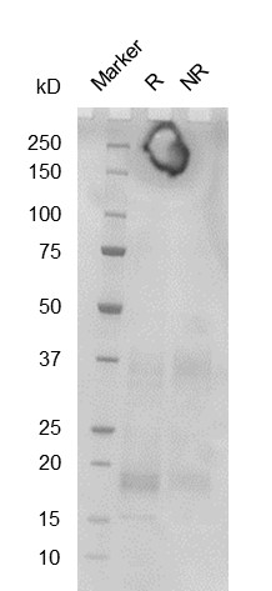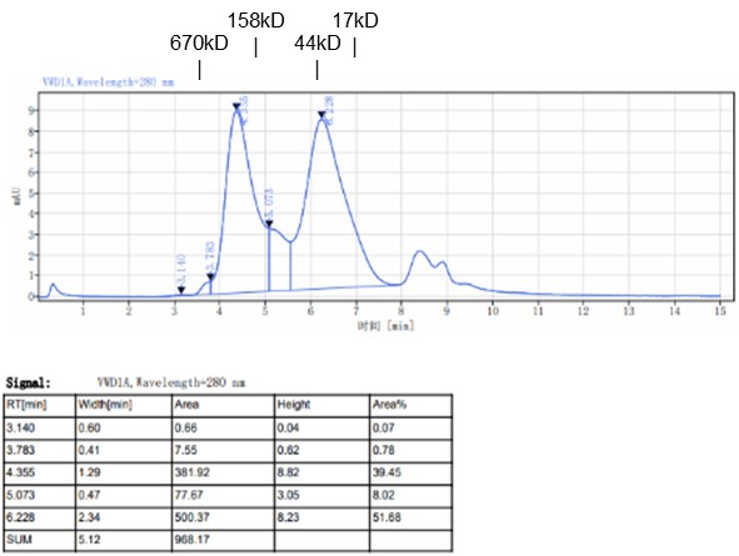mIL10(19-178, E114Q, Q150E)-His
Description
Interleukin-10 (IL10) is a pivotal immune regulatory cytokine that acts on many cells of the immune system where it has profound anti-inflammatory functions, mitigating excessive tissue damage caused by inflammation. It is produced by diverse mammalian cell types including macrophages, monocytes, T cells, B cells, keratinocytes, hepatic stellate cells, placental cytotrophoblasts as well as numerous hematopoietic cell lineages. Mechanistically, IL10 binds to its heterotetrameric receptor composed of IL10Ra and IL10Rb leading to JAK1 and STAT2-mediated phosphorylation of STAT3. Subsequently, STAT3 translocates into the nucleus where it drives expression of anti-inflammatory mediators. Notably, IL10 selectively targets antigen-presenting cells (APCs) such as macrophages and monocytes and inhibits their release of pro-inflammatory cytokines including GM-CSF, G-CSF, IFNg, IL1a, IL1b, IL2, IL3, IL6, IL8 and TNFa. Additionally, it interferes with antigen presentation by downregulating the expression of MHC-class II and co-stimulatory molecules, thereby inhibiting their ability to induce T cell activation. However, IL10 exhibits stimulatory properties towards certain T cells and mast cells, also enhances B cell survival, proliferation and antibody production. IL10 is a critical molecule in the control of viral infections and allergic and autoimmune inflammation. It promotes phagocytic uptake and Th2 responses but suppresses antigen presentation and Th1 proinflammatory responses. Knockout studies conducted in mice suggest the function of IL10 as an essential immunoregulator in the intestinal tract. Patients with Crohn’s disease react favorably towards treatment with bacteria producing recombinant IL10, showing its importance for counteracting excessive immunity in the human body. Human IL10 is active on murine cells, but murine IL10 is inactive on human cells.
Product name | mIL10(19-178, E114Q, Q150E)-His |
Species | Mus musculus |
Expression system | HEK293 |
Buffer | PBS, pH 7.4 |
Delivery condition | Dry ice (-80°C) |
Delivery Time | 1 week if in stock; 4 weeks if production needed |
Storage condition | Store at -80°C |
Brand | BioMetas |
Applications | Allergy Research, Cancer Research, Immune Checkpoint, Immune System, Immunotherapy, Inflammation Research, Neuroinflammation, Stem Cells & Differentiation, Targeted Therapy, Transplantation Research |
Aliases/Synonyms | IL-10, IL10A, cytokine synthesis inhibitory factor (CSIF), TGIF, B-TCGF, GVHDS, MGC126450, MGC126451, RP11-262N9.1 |
Reference | |
Note | For research use only. Not suitable for clinical or therapeutic use. |
Size | 1mg, 5mg, 10mg, 50mg, 100mg |
Brand | BioMetas |
Product type | Cytokine |
Expression system | HEK293 |
Applications | Allergy Research, Cancer Research, Immune Checkpoint, Immune System, Immunotherapy, Inflammation Research, Neuroinflammation, Stem Cells & Differentiation, Targeted Therapy, Transplantation Research |
Contact Us for a Quote!
Data Gallery
Fig. 1.) 4-20% SDS-PAGE analysis
Recombinant protein was visualized by Coomassie Brilliant Blue R250 staining.

Fig. 2.) SEC-HPLC analysis
Column: Superdex 200 Increase 5/150 GL
Running buffer: 2xPBS, pH 7.4
